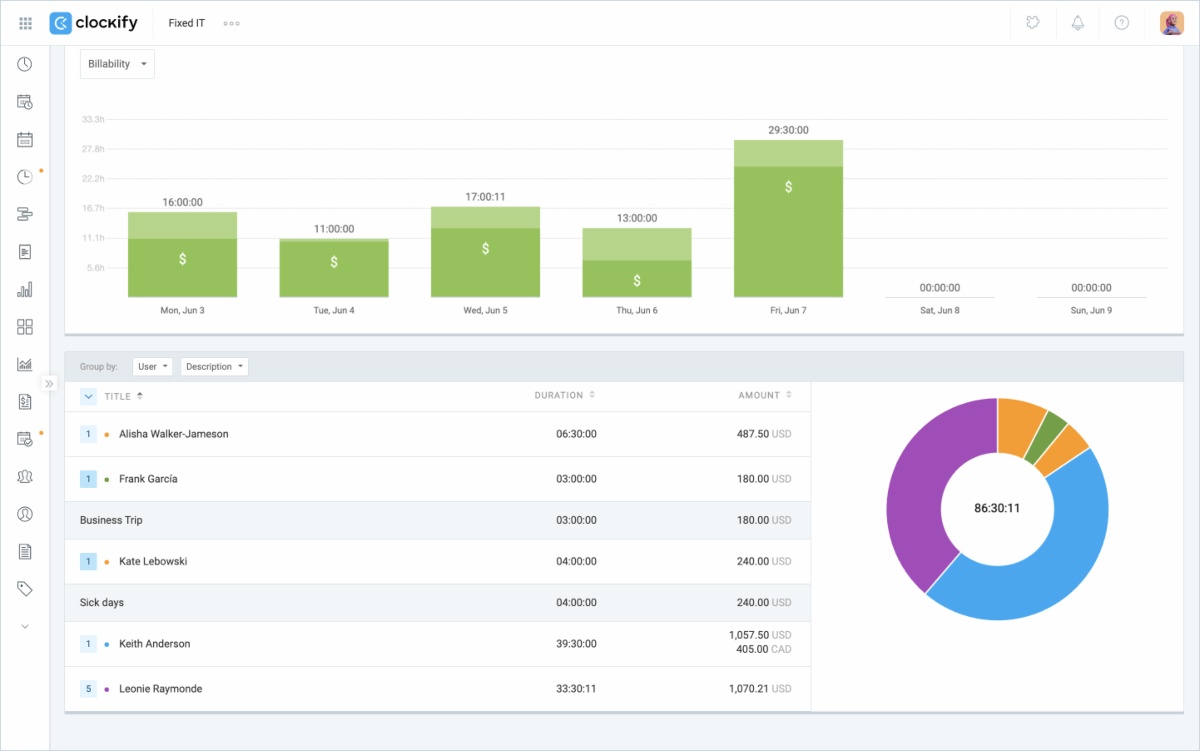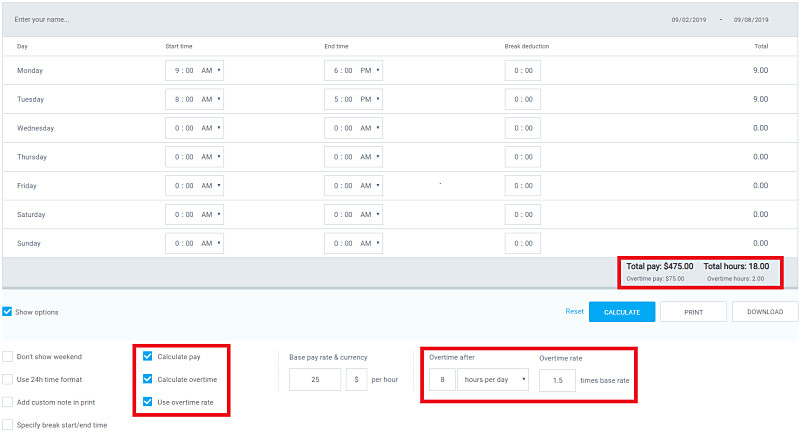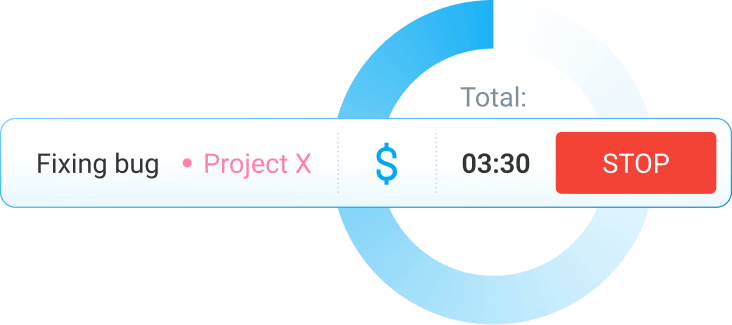45+ Timesheet Questions, Answered
Are you worried your employees might commit timesheet fraud? Or you’re struggling to understand the legal and financial implications of timesheet data in general? To dispel all the confusion, here are the answers to the most common timesheet questions.

1. What is a timesheet?
A timesheet is a record of the time an employee has spent working during a fixed period — such as a day, week, or month. Timesheets can also include information on which projects the employee worked on, for which client, and more.
2. Who invented timesheets?
The first name in the history of time tracking to be linked with the modern concept of a timesheet is Williard Bundy. He invented and later patented the first automatic mechanical time clock in 1888.

3. How do timesheets work?
Timesheets require employees to enter their hours worked each day. The time data can be more detailed — including work start and end times, break time, overtime, and more.
4. What are the types of timesheets?
We can distinguish timesheets based on the period they cover and the information they require:
- Monthly timesheets,
- Semi-monthly timesheets,
- Weekly timesheets,
- Bi-weekly timesheets,
- Daily hourly timesheets for employees,
- Daily timesheets for supervisors,
- Project timesheets, etc.

5. Why do I have to complete a timesheet?
As a small business owner, you need timesheets to:
- Bill clients accurately,
- Monitor project costs,
- Measure employee performance, and
- Track efficiency at work.
Most importantly, timesheets help you pay your employees properly. Timesheets completed accurately and on time are required for payroll processing.
6. Is timesheet a timecard?
No, timesheet isn’t a timecard — but these two are quite similar. They both serve as records of the hours worked. However, a timesheet records more data than a traditional timecard:
- A timecard is a timestamped card used solely to record an employee's start and end times at work — it's basically a simple clock-in/clock-out system.
- A timesheet records the time worked on projects, for client billing and payroll processing.
🎓 How Different Types of Time Tracking Software Work
7. Is a timesheet better than a timecard?
Whether timesheets or timecards are better for your business depends on your industry. It also varies depending on whether your workers work in an office, from home, or in the field.
For example, if you’re managing a team that switches between tasks, timesheets would be better suited, as they allow you to fill out such information.
On the other hand, if you’re managing restaurant workers who have set roles that don’t change — relying on timecards would be more practical.
8. What is a timesheet application?
A timesheet application is a digital solution for timesheet time tracking. Such software typically allows you to add start and end times for projects. Apps like Clockify can also calculate billable hours for payroll.

9. Do startups really need timesheet software to track employees and project performance?
Startups and other businesses aren’t legally obligated to track time using software — but timesheet software undoubtedly makes timekeeping easier.
If your startup team fills out their timesheets regularly, you'll be able to:
- Invoice clients easily and correctly,
- Pay your team properly,
- Control project cost, and
- Reduce the time spent on manual processes.
Moreover, timesheet software gives you precise records that serve as proof of your startup's work and progress. Such records may be crucial for winning over potential investors.
10. Why is a timesheet important in payroll?
One of the main uses of completed timesheets is calculating payroll. Payroll is calculated based on the hours of work added to the timesheet. Here’s how it works:
- Employees complete their timesheets,
- Hours the employees worked during a week or month are added up, and
- Total sum per employee is converted to decimal format and multiplied by their respective hourly rates (e.g., 7.5 x $30 = $225).
One option is to calculate payroll manually (if your business uses physical timesheets to track employee work time). However, automating the calculation with time tracking software is a much quicker and more precise solution.
11. How to properly fill out a timesheet for payroll purposes?
For a timesheet to be used for payroll purposes, it needs to contain:
- Employee name,
- Total hours worked,
- Overtime, and
- Hourly rate.
12. How to calculate earnings based on a timesheet?
To calculate the earnings you’ve made on a particular project using timesheet software, simply:
- Define your hourly rate for that project, and
- Enter all the time you've spent on that project.
Once you enter your data, the software automatically multiplies the time you've spent working on that project by your hourly rate. The results show your earnings for that project.

13. How to invoice a timesheet?
The easiest way to invoice a timesheet is to use invoicing software. Track billable hours, and then add their total to your invoice.
Once you enter the unit price, the invoicing software will calculate the total amount due. Apps like Clockify even let you import tracked billable hours directly into your invoice.

🎓 10 Best Free Invoicing Software for Error-Free Accounting
14. What is timesheet freezing?
Timesheet freezing means locking a digital timesheet so it can’t be edited. Many timesheet apps have this option. For example, you can lock the billable hours that employees tracked the previous month.
The main purpose of freezing timesheets is to ensure that data used for payroll or invoicing can’t be changed afterward.
15. Is a timesheet a legal document?
Yes, timesheets are legal documents, as the Fair Labor Standards Act (FLSA) requires employers to keep records of employee hours worked. These records ensure the employees are paid fairly and receive time off and benefits they are entitled to.
16. What is timesheet compliance?
Timesheet compliance is linked to several important federal acts and agencies — namely, the Fair Labor Standards Act (FLSA) and the Defense Contract Audit Agency (DCAA).
All employees who fall under FLSA rules and regulations (also known as non-exempt employees) need to comply with FLSA recordkeeping requirements, including:
- Hours worked each day,
- Total hours worked each week,
- Regular hourly rate, and
- Overtime pay.
For more information on keeping your timesheets compliant, check out our guides on FLSA and DCAA compliance.
17. What is timesheet attestation?
Timesheet attestation is the process in which an employee confirms timesheet accuracy. Attestation helps employers verify that timesheets are free of discrepancies, ensuring fair employee compensation.
18. Who is responsible for timesheet legitimacy, the employer or the employee?
Ultimately, it’s the employer's responsibility to make sure the time data provided by employees is accurate. That’s why, as the business owner, you should create clear policies to establish the rules for submitting timesheets. This will minimize timesheet inaccuracies, making it easier for you to ensure their legitimacy.
19. What industries require employees to track their work hours in a timesheet?
Employees from all industries can track time in timesheets. Timesheet time tracking isn’t legally required in any industry. However, FLSA mandates that all employers keep time records, regardless of the format they choose.
20. When do I have to complete and submit a timesheet?
The exact time and manner of submitting your timesheets will depend on your company’s timesheet policy. It’s best to complete your timesheets daily — while the exact tasks you worked on are fresh in your mind.
You’ll then need to submit your completed timesheets for approval to your assigned timesheet approver before the company-set deadline.
21. How do you prevent timesheet fraud in your company?
You can prevent timesheet fraud in your company by:
- Makingclear timesheet policies — to emphasize the consequences of going against the policies,
- Using timesheet software — to spot inaccuracies more easily, and
- Defining internal control and management report rules — to help identify payroll irregularities, excess work hours, and exceeded budget early on.
You’ll need to establish disciplinary measures for offenders. Once people know the consequences of timesheet fraud, they’re more likely to follow the rules.
22. Can an employer withhold pay from employees for a late timesheet?
In the US, the employer can’t legally withhold pay from employees, even if they haven’t submitted timesheets.
For example, the California Department of Industrial Relations clearly states that employees must be paid on time “regardless of whether the timecard is submitted.” The official state website of Oregon adds that an employer mustn’t delay or refuse to issue apaycheck as a form of disciplinary action, including for late timesheet submissions.
The employer is responsible for keeping accurate records of employee hours worked. If an employee doesn’t track time according to the employer’s policy, it’s up to the employer to address it. However, they’re still legally obligated to pay the employee.
23. How to fill out the break section of my work timesheet?
To fill out the break section in your timesheet, simply enter the time you spent on your break. Under federal law, short breaks (5 to 20 minutes) are compensable.
However, the lunch break (30 minutes or more) is typically unpaid time. Even in that case, breaks still should be added to the timesheet for compliance reasons.
24. Can an employer change a timesheet?
Yes, an employer can change a timesheet — the FLSA requires companies to keep work time records for their non-exempt employees. The responsibility for timesheet accuracy ultimately lies with the employer.
Because of this, employers have the discretion to change their employees’ time records. They must, however, ensure that the time records match the time the employees worked.
25. Are employee timesheets confidential?
Yes, employee timesheets are confidential — in certain cases. A timesheet is considered confidential if it contains:
- Performance evaluation,
- Leave time, or
- Social security number.
In other words, it’s forbidden for the local government to provide access to such timesheets.
If the timesheet contains only information about an employee’s work hours, it likely falls under the Public Records Law and isn’t confidential. Such timesheets are used for payroll and are considered financial records rather than personal records.
26. Can I recover missing wages if my employer used faulty timesheets?
Yes, you can take action to recover missing wages. Employees may suffer one or more of the following problems due to faulty timesheets:
- Unpaid minimum wages,
- Not being paid for all hours worked (including overtime), and
- Employee misclassification.
If you haven’t been paid the wages you are owed under the FLSA, you can file a complaint with the Wage and Hour Division (WHD) of the US Department of Labor or file a lawsuit directly against your employer.
However, before taking any legal action, you should approach your employer informally to try to resolve the issue. Maybe your employer or payroll department made an honest mistake — in that case, a simple conversation could straighten things out.
27. Is the daily accuracy of a timesheet important if the end check is the same?
Yes, the timesheet accuracy is essential. Apart from ensuring legal compliance, keeping accurate timesheets is vital for billing clients correctly and establishing a professional client relationship. If the client demands proof of work when a problem occurs, you’ll be able to send them the timesheets in a couple of clicks.
However, if a problem arises and your timesheets aren’t precise enough, many problems may befall your business — even if you’re right. For example, you may lose the contract, the client may ask for a money refund, and your reputation may be damaged.
28. What will happen if I submit a timesheet too late?
Submitting a timesheet late may result in:
- Payroll errors,
- Paycheck and billing delays,
- Project management issues,
- Disputes with clients.
Depending on the company policy and frequency of late timesheet submissions, employees may face penalties. This can range from disciplinary action (e.g., written/verbal warning or suspension) to termination of employment.
29. What security measures are necessary to protect sensitive timesheet data?
For effective protection of sensitive timesheet data, employers should adopt certain security precautions:
- Administrative measures — doing regular audits, establishing cybersecurity policies, and conducting security training sessions.
- Technical measures — implementing Multi-Factor Authentication (MFA) for timesheet system logins, using VPNs to prevent third parties from intercepting sensitive data, and regularly updating your timesheet software.
As a project manager, you can also protect sensitive timesheet data from internal threats by reviewing access permissions. For instance, you can restrict access for employees who have left the organization or changed roles.
30. What happens if you lie on a timesheet?
Lying about your timesheet can get you into serious trouble.
Say you’re obliged by company policy to arrive at work at 7:00 a.m., but you arrive at 7:20 a.m. and still write that you arrived at 7:00 a.m. And once confronted about it — you lie, saying your timesheet is correct.
But there’s an easy way anyone can check this, and the consequences of your lying can be great (e.g., you may get fired or face a civil lawsuit). In some cases, timesheet fraud can lead to criminal charges and heavy fines.
So, it’s best to own up to it and admit that you lied. This way, you’ll avoid severe disciplinary actions at work — especially if it’s your first offense.
31. Can I fill in a timesheet for someone else?
Filling out a timesheet and adding time for others is legal if you’re a supervisor adding time for payroll processing. But the person who worked the said hours needs to review the timesheet before submission. If there are inconsistencies, they’ll need to notify the supervisor.
If everything’s correct, both the employee and the supervisor will also usually need to sign the timesheet to verify its accuracy.
32. Is my former employer obligated to provide me with a copy of my timesheet?
Whether your former employer is legally obliged to give you access to your timesheets depends on the state in which you were employed. Since the US lacks a federal law governing employee access to their personnel files (including timesheets), this right depends on state law.
For instance, employers in Alaska are required to allow all their current and former employees to view and copy their personnel files. Also, public employees in Texas can request their files under the Public Information Act. Conversely, private employees don’t have this right (unless the company policy allows it).
33. How to avoid a user filling out timesheets for old projects?
With Clockify, you can avoid workers filling out timesheets for old projects by:
- Locking employee timesheets before a certain date, or
- Placing an automatic lock on their time entries that comes into motion after a fixed point (e.g., you can set the automatic lock to come into action on Wednesday, and lock editing of time entries for the previous 2 weeks).
Setting an automatic lock is a great option if you’re worried you’ll forget to lock the timesheets manually.
34. When are state holidays observed?
State holidays are observed on specific dates determined by each US state and can vary widely. Also, many state holidays align with federal holidays.
The majority of US businesses with PTO honor the following federal holidays:
- New Year’s Day (January 1),
- Memorial Day (last Monday in May),
- Independence Day (July 4),
- Labor Day (first Monday in September),
- Thanksgiving Day (fourth Thursday in November), and
- Christmas Day (December 25).
35. If you’re a contractor with a paid holiday week, is a holiday week 0 hours on a timesheet, or does it fall under your total project time?
How your paid holiday time will be classified depends on the company you work for as a contractor.
Say you have a contract for 48 hours per week over 20 weeks. If you take 1 paid holiday week, some companies will count that time (48 hours) as holiday — i.e., time separate from the project. Others will count it toward the project’s total time. If unsure of how to add this time to your timesheet, ask the relevant personnel in your contracted company.
36. How to schedule a timesheet?
To ensure your timesheet system runs smoothly, you can devise a schedule that requires your team to log a set number of work hours within a fixed time period.
You should also set up a reminder system to ensure your employees log their scheduled hours.
Clockify lets you set time-tracking targets for your team. Then, the app will automatically remind them via email if they haven’t logged their daily/weekly/monthly target hours.

37. What do people timesheet for bathroom breaks?
Bathroom breaks generally fall under the category of short breaks. As such, they’re treated as compensable work time.
While typically not required, some employees may need to log their bathroom breaks if stated in their employer’s policy. This allows employers to:
- Track employees’ overall unproductive time, and
- Identify potential time misuse (e.g., if an employee takes excessive breaks to make personal phone calls).
38. How to create a timesheet in Jira or other popular business tools?
To track time in Jira or other popular business tools for timesheet purposes, use Clockify’s browser extensions for Chrome, Firefox, orEdge.
You’ll be able to track time on Jira tasks directly from Jira and have them automatically synced with Clockify’s web version. Then you can export the data in a timesheet format to Excel or CSV.
🎓 Master Jira Time Tracking With Our Step-By-Step Guide for 2025
39. How to add overtime to a timesheet?
Under US overtime regulations, non-exempt hourly employees are entitled to overtime pay. So, they should be careful when adding this time to their timesheets.
An efficient way to add overtime and calculate overtime pay is to use a time card calculator. Your overtime pay is automatically calculated based on your base pay rate and overtime rate.

🎓 5 Steps to Calculating Overtime to Avoid Payroll Mistakes
40. How to measure the creative output of workers who are not filling in the timesheet?
If your employees aren’t filling out their timesheets to measure their creative output, you can still guide them to the results you want by:
- Defining a roadmap for your project or the product you’re developing,
- Assigning the tasks directly to your team members and then asking them to make time estimates for the tasks’ completion, and
- Reviewing task progress regularly through standup meetings.
However, completing tasks from the roadmap in a random order and adopting a lax policy on progress checks can hurt the project and your employees’ productivity in the long run. Instead, filling out timesheets is less of a hassle when tracking and maintaining project progress, even for creative workers’ output.
41. How to fill out a timesheet if your team spent the entire day in a training session?
How you’ll record your team’s time spent on internal training sessions depends on your company’s policy.
The time spent on team training sessions can be categorized under Training or Professional development projects.
When you log your training hours, tie them to a specific project (e.g., Professional development) and mark them as non-billable to ensure they’re properly recorded.
42. What are the common challenges when implementing a new timesheet system, and how to overcome them?
Some common challenges when implementing a new timesheet system are:
- Employee resistance due to fear of the unknown,
- Difficulty using a complex or non-intuitive timesheet tool,
- Integration issues, and
- Data privacy concerns.
To make the transition smoother, explain the benefits of the new timesheet system to your employees (like improved productivity and reduced admin stress). This way, they’ll accept changes quickly and be more motivated to use the new system consistently.
Also, to avoid employee frustration, ensure the system isn’t overly complicated to use. After all, a timesheet tool should make timekeeping easier — not add more work or confusion.
43. How can employees track their time for non-billable tasks, such as internal meetings or professional development?
With a powerful timesheet application like Clockify, employees can easily record time spent on non-billable tasks.
To track non-billable time spent on an internal meeting, do the following:
- Open the timesheet page in Clockify,
- Choose a project (e.g., Internal), and
- Add your work hours in the appropriate slot.

Then, hover over the time entry, click the 3 dots, and turn the Billable switch off to mark time as non-billable.
All your non-billable and billable hours will be sorted in Clockify’s reports, where you can analyze them in detail.
44. What is unallocated time, and how is it represented in a timesheet?
Unallocated time (UAT) refers to time that hasn’t been assigned to a specific task, project, or client.
On a timesheet, UAT can represent time spent on:
- Breaks,
- PTO,
- Sick leave, or
- Non-billable admin work.
🎓 How to Track Resource Allocation
45. How to create a simple timesheet in Google Sheets or Excel?
To create a timesheet in Excel and calculate employee hours automatically, you need to:
- Include basic labels (date range covered, employee name, pay rate, etc.),
- Add timesheet labels (day, work start and end times, break start and end times, total hours, etc.),
- Define Excel formulas for automatic calculations,
- Format cells for more clarity, and
- Download your timesheet for client transparency.
🎓 Free Excel Timesheet Template (+ Guide & Top Alternative)
46. How can we automate timesheet compilation company-wide?
Automating timesheet compilation company-wide is only possible by using timesheet software. This way, all your employee timesheets are grouped, sorted, and organized in one secure place.
The employees log in to the software using their personal accounts and complete their timesheets. As the admin, you can then track and analyze their project progress in real time.
47. What is the relationship between timesheet software and productivity?
Tracking time with timesheet software has proven to have many productivity-related benefits for businesses. Some of these benefits include:
- Discouraging multitasking,
- Improving focus on your priorities,
- Encouraging prioritization,
- Staying organized and on schedule,
- Increasing team accountability and transparency, and
- Minimizing time theft.
You could achieve great work results by having your employees fill out paper timesheets with a pen or by using a different non-electronic timesheet method.
However, timesheet software facilitates better productivity and time management by automating these processes, making everything easier and more efficient.
Bonus: What is a great free time tracking timesheet software?
For a simple, free, and efficient timesheet tracking solution, try Clockify.
You’ll get a reliable record-keeping software that allows you to store months and years of timesheet data, for an unlimited number of:
- Users,
- Projects,
- Tasks, and
- Clients.

Within the timesheet page of the app, you’ll be able to:
- Add, delete, and edit timesheet rows,
- Add as many projects per day as you need,
- Have all the time calculated automatically — and then shown in the Reports section together with earnings,
- Copy a timesheet template with projects from last week and just fill in the template with new data this week,
- Create timesheet templates you can use at any time, and
- Add time for others through the Teammates option.
You’ll also be able to export your team’s timesheet data in Excel, CSV, and PDF for client billing or payroll.
Using an efficient and easy-to-use timesheet solution like Clockify allows small business owners and project managers to:
- Track employee work hours accurately (especially for remote or flexible work),
- Prevent timesheet fraud,
- Ensure compliance with labor laws and avoid legal issues related to timesheet compliance,
- Save time and reduce administrative burden, and
- Get better insights into team performance and resource allocation.
Moreover, having precise timekeeping data helps you ensure accurate client billing and improve profitability.
Clockify also offers free, full human customer support (available 24/7 via chat, email, and phone) if you have any questions about setting up or using Clockify.
Streamline the timesheet process and improve business operations with a simple yet effective timesheet tool.
